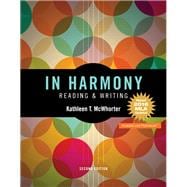For combined courses in Developmental Reading and Writing.
This version of In Harmony: Reading and Writing has been updated the reflect the 8th edition of the MLA Handbook (April 2016) *
A focus on sentence- and paragraph-level reading and writing skills
In Harmony, Second Edition is the first text in a two-part integrated reading and writing series. This volume focuses on sentence to paragraph reading and writing skills, while In Concert moves on to explore paragraph and essay level reading and writing. This series aims to show students how reading and writing unite to become a single process of understanding and expressing ideas.
Emphasizing the harmonious nature of the reading and writing processes, it highlights critical thinking and reinforces its relationship to these processes. Student and professional readings are presented at the start of each chapter and used as the basis for instruction, illustration, and practice. Readings are presented as integrated instructional material, rather than as models or additional practice, allowing students to improve on their own reading and writing skills through a single source. Thematic-based chapters help build continuity, elicit student interest and help students draw on their own prior knowledge. McWhorter’s streamlined presentation and flexible approach work in traditional as well as compressed courses.
*The 8th edition introduces sweeping changes to the philosophy and details of MLA works cited entries. Responding to the “increasing mobility of texts,” MLA now encourages writers to focus on the process of crafting the citation, beginning with the same questions for any source. These changes, then, align with current best practices in the teaching of writing which privilege inquiry and critical thinking over rote recall and rule-following.








